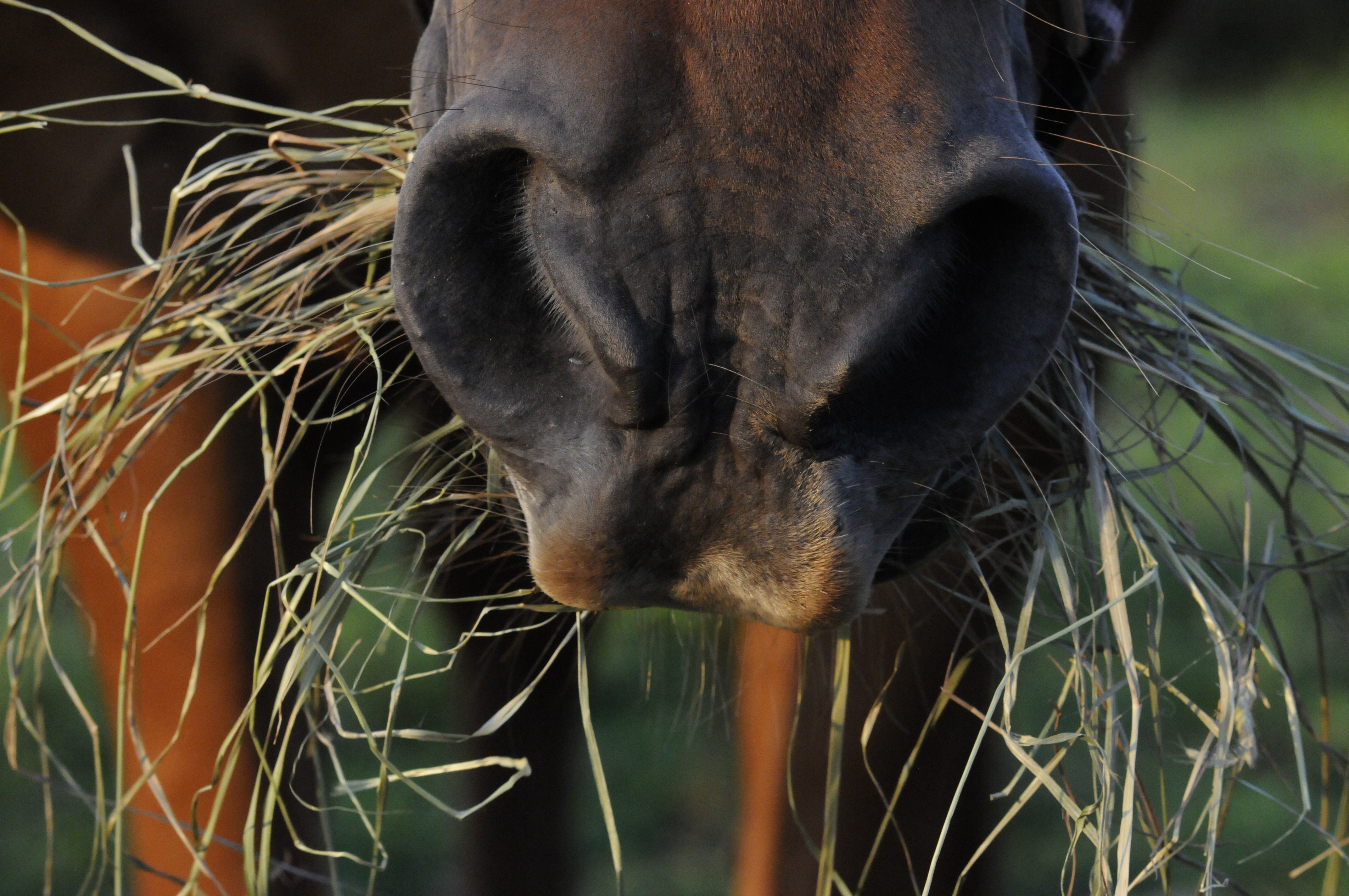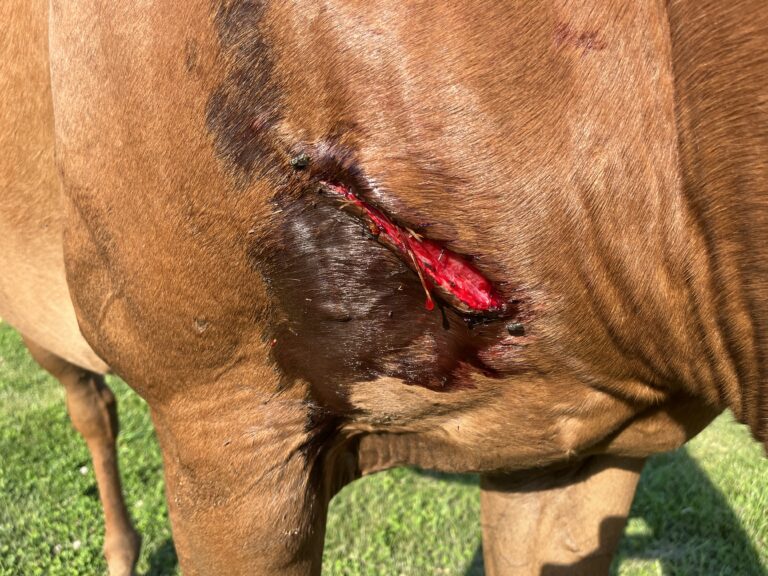It is difficult to know what to call it—chronic obstructive pulmonary disease (COPD), heaves, recurrent airway obstruction (RAO), summer-pasture associated obstructive pulmonary disorder, broken wind, allergic bronchitis, inflammatory airway disease or the all-inclusive, more recently suggested “equine asthma”—but it is very easy to spot when a horse is affected by it. Such a horse will be coughing and wheezing with labored respiratory efforts. A distinct nasal flaring will be noted along with a deep contraction of the abdominal muscles with each breath. Affected equine athletes will be thin (from all the muscular effort needed just to breathe) and will be resistant to or totally unable to exercise and perform. A closer examination with a stethoscope will reveal increased lung sounds, often with whistles or crackles heard, indicating the presence of mucus in the airways and possibly damaging fibrin deposits in lung tissue. Not all horses with equine asthma will be affected to this degree, but all horses with this condition will find breathing difficult and should be treated because of the progressive nature of the disease. Left untreated, equine asthma will severely reduce your horse’s ability to perform and can progress to be debilitating, if not fatal.

)
Equine asthma is common. The number of horses affected with some type of serious asthma is estimated to be 14 percent in the northern hemisphere. This number is an aggregate of all the types of asthma and there is ongoing research looking to get percentages for each individual type of asthma (e.g., COPD versus RAO versus summer pasture-associated allergic bronchitis, etc).
It is currently thought that equine asthma results from a hypersensitivity to inhaled allergens similar to what occurs in human asthmatics. There is some inherited component to this disease and a large environmental factor as well. Certain plants, grasses, trees and weeds release pollen at specific times during the year. This pollen contains countless numbers of allergens that irritate and stimulate the immune system and, in specific individuals, generate an exaggerated systemic response. The mucous lining of the bronchi (the large airways in the lungs) swells, becomes thicker and produces fluid that closes or obstructs the air passages. The horse must work to breathe and over time this response damages the elastic nature of these airways and the horse must now use his muscles to force air out of the lungs.
Horses can be affected by other allergens as well and dust, air pollutants, mold, animal dander, fly sprays, smoke and smog, cleaning chemicals and many other substances can trigger an asthmatic response. This wide array of causes and the various times of the year when and locations where allergens may be present help explain the many names that have been given to equine asthma over the years.
Owners can provide a significant amount of help to their asthmatic horses simply by being observant. Does your horse cough and breathe with more difficulty when in the stall or in the pasture? Does your horse cough more when eating round-bale hay or after being put in a stall with fresh shavings? Is it harder to exercise your horse on dry, dusty days or does your horse perform worse in hot, humid weather?
We know that hay and straw are significant sources of allergens and can cause most asthmatic horses difficulty. Some horses, on the other hand, are more affected by grass allergens and cough more at pasture while others are more sensitive to dust and therefore find breathing more difficult when in a stall. Watching and recording those situations that make your horse cough and struggle to breathe can lead you to being able to identify your horse’s unique asthma triggers and then to developing a treatment/management program to help.
Treatment for horses with asthma must incorporate both environmental and medical management. One without the other will simply fail. When dealing with asthmatic horses, hay should not be stored above stalls and dusty, moldy hay in all forms should be avoided. Soaking and/or wetting the hay to reduce allergens can be helpful for some horses. Barns and stalls should be clean and free of dust. Straw or pine-shaving bedding is often not tolerated by horses with asthma. Low-dust bedding is preferred in these reactive cases. Most owners looking to reduce dust from shavings will wet their shavings or use a commercial low-dust product such as wood pellets or any one of the hundreds of equine pelleted bedding products on the market. Peat moss is also a good alternative to use. It seems dusty, but the particles are so large that they do not get deep in the lungs and are very low in allergens.
The two most commonly used types of medical management for equine asthma are corticosteroids and bronchodilators. Bronchodilators are a class of drugs that can be given by mouth or inhaled through the nose. Drugs such as albuterol and clenbuterol function by opening up, or dilating, the large airways in the lungs, allowing for more airflow. Many people use inhalers with these drugs to treat their asthma, and equine air masks and versions of inhalers for horses are also now available. Corticosteroids are powerful anti-inflammatories that help reduce swelling and combat the excessive immune response that is at the root of equine asthma cases. Dexamethasone can be given orally or by injection and it is often used in severely reactive asthma cases because of its strong and rapid response rate. It can have negative effects, however, and is not a long-term asthma solution. Prednisolone is not as strong a corticosteroid but it also does not have as many severe side effects and it often becomes a part of an equine asthmatics treatment program. Aerosolized and inhaled corticosteroids, such as beclomethasone and fluticasone, require less of a dose because they are directly delivered to the area (the bronchi and airways) that are most severely affected.
Truly successful equine asthma treatment programs incorporate elements from all aspects of breathing management. The environment must be considered and all steps must be taken to increase airflow and reduce allergen exposure. Dressage work may be avoided on smoggy days or done in an airy, open field rather than in a dusty ring. Hay might need to be soaked before feeding and dusty round bales should be removed from the pasture. Bronchodilators and corticosteroids may be used as needed to control inflammation and inhalers may be added to further aid breathing. Many horses struggling with equine asthma can be successfully managed and can continue to show and compete. It requires dedication from the owner, however, and a long-term commitment to keeping this severe and progressive disease under control.
Kenneth L. Marcella, DVM, graduated from the New York State College of Veterinary Medicine at Cornell University. He has been an FEI veterinarian in multiple equine disciplines for nearly 30 years and is a member of the veterinary selection panel for the USA Endurance Team. He will serve as head team vet for endurance at the upcoming World Equestrian Games. He is board-certified in veterinary thermography by the American Academy of Thermography. With a special interest in lameness and sports medicine, he operates KLM Equine in Canton, Georgia.











